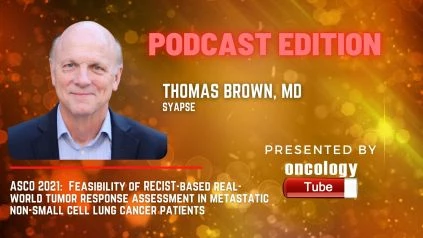Thomas Brown, MD, Chief Medical Officer, Syapse speaks about ASCO 2021 Abstract – #e21121 – Feasibility of RECIST-based real-world tumor response assessment in metastatic non-small cell lung cancer patients.
Link to Abstract:
https://meetinglibrary.asco.org/record/201064/abstract
Background:
The Response Evaluation Criteria in Solid Tumors (RECIST) is commonly used to assess treatment response to anti-cancer medicines for advanced lung cancer, however, it is not widely used in real-world settings. With real-world evidence increasingly being used to back promising treatments, this study looked into the feasibility of assessing real-world lung cancer response using RECIST-based measurement of lesions on archived radiologic films and comparing it to treatment response based on oncologist narratives in electronic health records (EHR).
Methods:
The Syapse Learning Health Network of US community health systems provided 30 randomly chosen metastatic non-small cell lung cancer (mNSCLC) patients diagnosed between January 2015 and December 2019. Patients had to be at least 18 years old, have histologically confirmed mNSCLC, have had no other malignancy within the previous two years, have started index systemic treatment after progression on platinum or anti-PD(L)-1-containing therapy, and have had at least one additional scan during the index period. Patients were tracked from the start of index therapy until the start of a post-index treatment line, death, or the date of the last contact, whichever came first. Tumor response was determined by comparing the responses described in medical oncologists’ narratives to a radiologist’s assessment of archival pictures using RECIST v1.1 criteria. Complete or partial response (CR/PR), stable disease (SD), progressing illness (PD), and not evaluable were the best overall responses (NE).
Results:
The median age at diagnosis of mNSCLC was 62 years; 22/30 (73%) were men, 28/30 (93%) were White, and 2/30 (7%) were Black. 21 (95%) of the 22/30 (73%) patients having a confirmed Eastern Cooperative Oncology Group performance status had a 0 or 1 status. Patients were followed for an average of 8 months, with the majority (63 percent) surviving until the end of the research. The best overall response between medical oncologist-reported and radiologist-reassessed answers was 67 percent, SD 79 percent, and PD 80 percent, as shown in the table. The lack of CR/PR confirmation in medical oncologists’ narratives, the absence of narratives, or the existence of clinical symptoms were all reasons for discordance.

